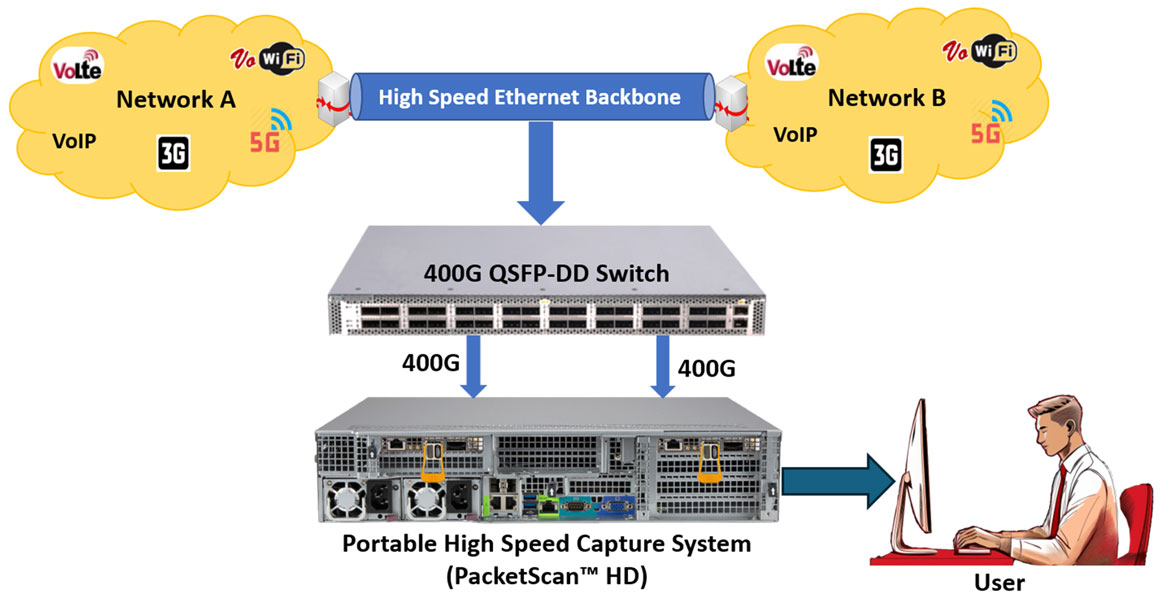Introducing 400 Gbps Duplex Wirespeed Packet Capture and Storage
Welcome to the latest issue of GL’s newsletter! We are excited to introduce our duplex wirespeed packet capture solution. This hardware platform performs lossless packet capture and analysis on 400G Ethernet networks and can be deployed in data centers or core high-speed network infrastructure.

Overview
Data traffic over Ethernet networks is growing rapidly with the emergence of large-bandwidth applications such as Artificial Intelligence models. Network engineers must ensure that networks can handle the increasing volumes of traffic generated by businesses. To meet this need, powerful diagnostic tools are required—tools that can connect to ultra-high-speed networks (400 Gbps and beyond), capture traffic, and perform real-time analysis, all within a single platform. GL provides an all-in-one platform that can capture high-speed Ethernet traffic without loss across multiple ports. This hardware solution, PacketScan™ HD, comes in both rack-mount and portable form factors, allowing network engineers to deploy it in a wide range of network and field environments.
The PacketScan™ HD has now been enhanced to support 400 Gbps data rates. Specifically, two software applications that run on PacketScan™ HD, FastRecorder™ and PacketExtractor™, have been enhanced to capture and analyze traffic at 400 Gbps without loss. These applications also now feature a Linux-based web interface, allowing multi-user access from anywhere on the network. The solution enables reliable, continuous packet capture over long durations, directly storing data on high-capacity NVMe SSDs (up to 240 TB).
High-Speed, Non-Intrusive Data Capture
FastRecorder™ captures Ethernet traffic in real time at bidirectional rates up to 800 Gbps through a non-intrusive fiber tap. Data is written directly to NVMe storage (up to 240 TB) for extended-duration recording. The system also provides detailed capture metrics, including duration, data rates, frame statistics, dropped packets, and total recorded bytes, along with port-level statistics like link status, bandwidth usage, error counters, and frame length distribution. This streamlined design simplifies packet capture, even in complex, high-speed network environment.
Advanced Data Extraction and Analysis
PacketExtractor™ operates offline to process previously recorded traffic. Users can apply filters, define time windows, or size limits, and extract specific streams or packet segments (e.g., headers) for targeted analysis. It supports PCAP and PCAPNG output formats, enabling detailed diagnostics. The tool also reports key extraction metrics such as frame count, data volume, extraction rate, and total processing time, making it easy to assess performance and traffic characteristics. Extracted files from FastRecorder™ and PacketExtractor™ can be analyzed using GL’s PacketScan™ software (installed on the same platform).
Key Features
- Duplex 400 Gbps capture (400 Gbps East + 400 Gbps West) up to 800 Gbps total to SSDs, recording up to 6 TB per minute
- Offers multi-user support through a single web-based user interface
- Lossless wirespeed capture of IP traffic across 400, 200, 100, 50, 40, 25, 10, and 1 GigE links
- Offers Packets Per Second (PPS) receiver modules for inter-system sync and nanosecond timestamping
- Test automation and regression testing via Python and REST APIs
- Real-Time troubleshooting and performance analysis
- Apply hardware filters based on MAC, 802.1Q (VLANs), IPv4 and IPv6, Tunnel Traffic, TCP, UDP, and SCTP parameters to record traffic of interest
- Monitors total recording duration, receive rates, record rates, frame rates, captured frames, dropped frames, and recorded bytes for efficient and accurate high-speed packet capture
- Provides real-time insights into port status, received frames, link utilization, capture rates, error counts, and frame-length distribution for efficient network performance analysis
- Users can view real-time graphs for each port to analyze capture rates and detect issues like segment drops, Multi-Packet Receive Queue (MPRQ) buffer overflows, missed packets, and discarded packets during recording
- Extract traffic into PCAP/PCAPNG using filters or limits (time, size, packet count)
- Slice packets to a limited length to optimize output trace size
- Provides detailed insights into the extraction process, including frame count, data volume, processing and extraction rates, and total duration for efficient traffic analysis
 Back to Newsletter Index Page
Back to Newsletter Index Page